Singapore Rolls the Dice
-
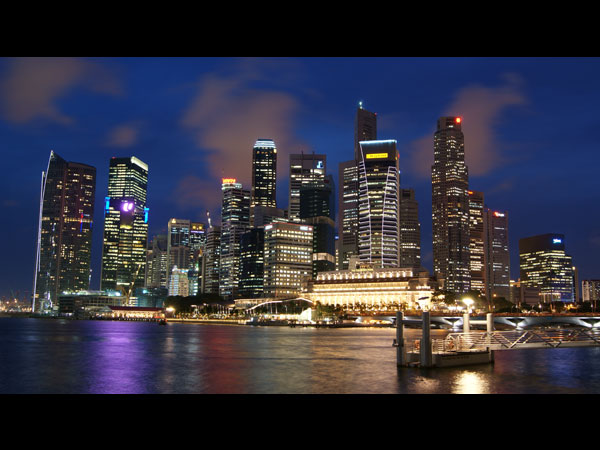 Singapore Skyline with dark blue sky in the background. Image by Merlion444, via Wikipedia. This image is in the public domain.
Singapore Skyline with dark blue sky in the background. Image by Merlion444, via Wikipedia. This image is in the public domain.In 2004, the Singapore government announced that it was entering the gaming business, joining Macau, whose gambling revenue for a single month recently exceeded $1.5 billion, making it the world's top gaming city. The chief source of this flood of money is China, where gambling, while immensely popular, is illegal. The combination of a notoriously authoritarian, not to say puritanical, city-state and gambling is bizarre. Needless to say, there will be no Singapore Strip. Instead, the government has authorized what it euphemistically calls integrated resorts, stand-alone vacation destinations that will include cultural and recreational amenities, as well as hotels and casinos. Developers were invited to submit bids for two different sites, one near downtown on Marina Bay and the other south of the city on Sentosa Island. The island site was awarded to Genting Berhad, a Malaysian conglomerate that opened the first phase of its Resorts World Sentosa this year.
-
 Image courtesy Resorts World Sentosa and Michael Graves & Associates.
Image courtesy Resorts World Sentosa and Michael Graves & Associates.Sentosa Island, which covers 2 square miles, is connected to Singapore's main island by light rail, cable car, and a causeway, which bring day visitors and tourists to the beach hotels, golf courses, and forested parkland. The $4.3 billion casino resort will spread over 121 acres and include a Universal Studios theme park and a marine-life park as well as hotels, shops, and restaurants. The master plan, like all the buildings (with the exception of the theme parks), is the work of Michael Graves & Associates.
-
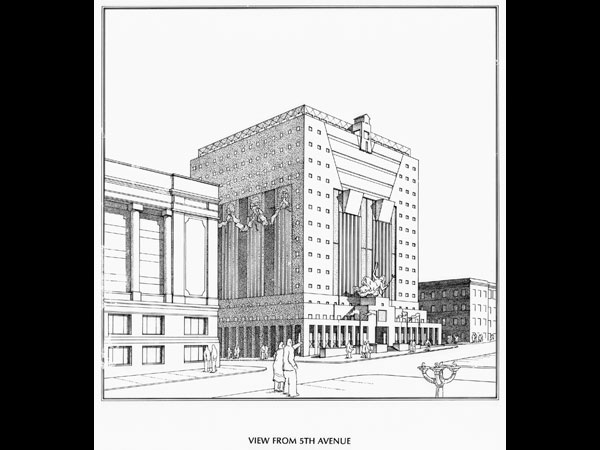 Portland Building Sketch. Image courtesy Michael Graves & Associates.
Portland Building Sketch. Image courtesy Michael Graves & Associates.Michael Graves as master planner may come as a surprise; early in his career, he was responsible for a famous whistling teakettle, and he is best known as the designer of individual buildings. His first prominent commission, a municipal office building in downtown Portland, Ore., kicked off architectural Postmodernism. The Portland Building caused a furor when it was built in 1980 because it questioned many tenets of architectural Modernism: It didn't feature Modern materials or structural systems, it was colorful when Modern buildings were monochrome, and it was ornamented when Modern buildings never had decorations. On the other hand, while the design of the building was iconoclastic, the way that it fit into the city was downright traditional—politely hugging the sidewalk, providing a pedestrian arcade, incorporating a work of civic sculpture.
-
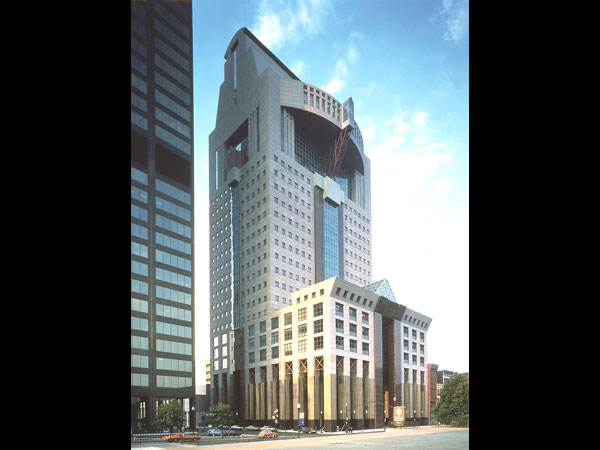 Humana Building. Image courtesy Michael Graves & Associates.
Humana Building. Image courtesy Michael Graves & Associates.Graves' traditional urbanism is visible in his breakthrough project of the 1980s, the Humana Building in Louisville, Ky., which he won in a competition beating out such heavyweights as Cesar Pelli, Helmut Jahn, Ulrich Franzen, and Norman Foster. Paul Goldberger called Humana "a remarkable achievement—in every way Mr. Graves's finest building." Postmodernism lasted only a decade, and Graves fell out of favor with the critics—he is regularly passed over for the Pritzker Prize—yet the clients continued to come. He is responsible for scores of government and university buildings in the United States and has recently built the ministry of health and sport in The Hague, a hotel in Antwerp, a museum in Taiwan, and a mixed-use project in Egypt. Graves has also ventured where most architects fear to tread—into the mass market. He has designed household items for Target and a line of faucets for Delta, and is currently working with Stryker, a national manufacturer of hospital equipment.
-
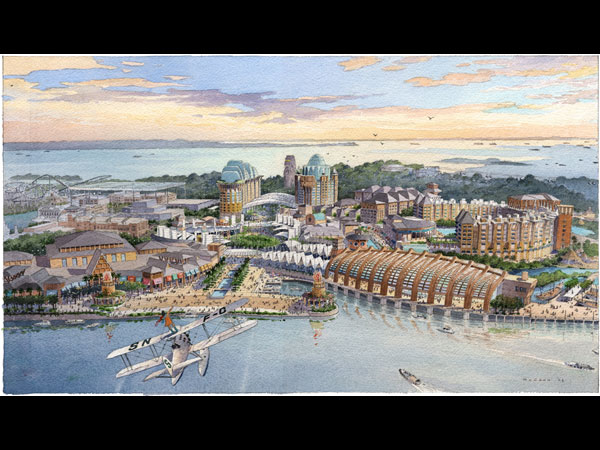 Image courtesy of Resorts World Sentosa and Michael Graves & Associates.
Image courtesy of Resorts World Sentosa and Michael Graves & Associates.Graves characterizes the pedestrian landscape of the Sentosa resort, with its plazas and fountains, as a blend of Coney Island and Chicago's World's Columbian Exposition, but this is definitely not a White City. "Singapore is a commercial, grey, concrete-and-glass city," he says. "We wanted Sentosa to be different, colorful and lyrical." The ribbed structure in the foreground is a maritime museum, which recalls that Singapore was an important stop on the historic silk route. The giant existing statue framed by the two taller buildings is the city's symbol, the merlion, an imaginary creature with the head of a lion and the body of a fish.
-
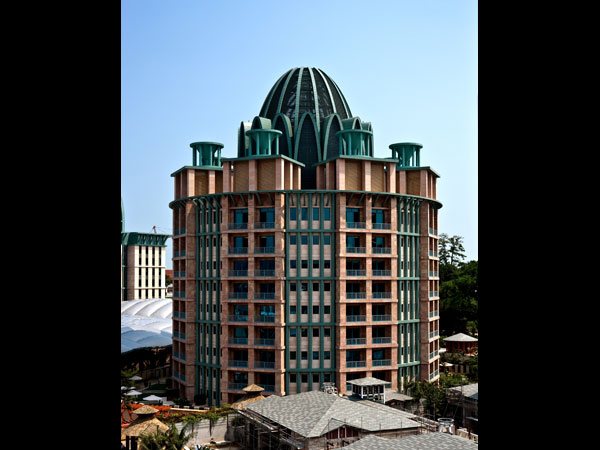 Image courtesy Resorts World Sentosa and Michael Graves & Associates.
Image courtesy Resorts World Sentosa and Michael Graves & Associates.Part of Graves' appeal to clients is his willingness to adapt his architectural style to local conditions. "Asians don't want to borrow from Western culture," he observes. "They want their own architecture. Although they don't necessarily know what that is." What he has given them at Sentosa is definitely different from the simplified Classicism with which he is often associated. The Crockfords hotel, for example, looks vaguely tropical, with copper-clad curved roofs that echo the island's forest-covered hills. Despite the urban density of the resort, the scale of the buildings is low. The 1,740 hotel rooms (considerably fewer than a single mammoth Las Vegas hotel), are distributed among six medium-rise hotels, each intended for a different clientele: Crockfords for high-rollers, a family hotel, beachfront villas, a luxury hostelry, and the casual Michael (yes, that Michael).
-
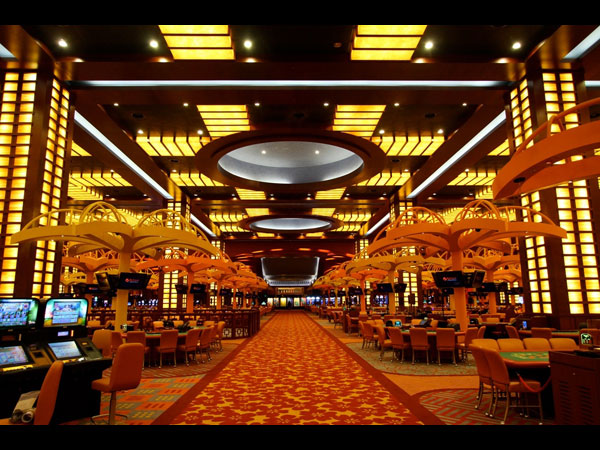 Image courtesy Resorts World Sentosa and Michael Graves & Associates.
Image courtesy Resorts World Sentosa and Michael Graves & Associates.Sentosa looks like a collection of individual buildings among plazas and promenades, but the resort sits on top of a huge four-story underground basement that contains service tunnels, vehicular access, parking garages, mechanical spaces—and the casino. The subterranean location was intentional, since the government demanded that the casino not be visible from any of the public areas in the family resort. Unlike Las Vegas, where everyone is obliged to walk through the gaming areas, access to the Sentosa casino is restricted; in fact, locals must pay a steep entrance fee. The décor of the gaming area is Matisse-meets-Star Wars. "Our client really liked red," says Patrick Burke, the studio head at MGA in charge of the project.
-
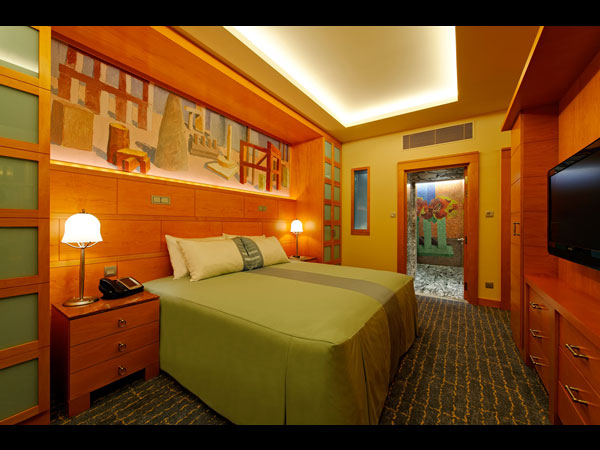 Image courtesy Resorts World Sentosa and Michael Graves & Associates.
Image courtesy Resorts World Sentosa and Michael Graves & Associates.The size of the smallish guestrooms (the total square-footage of the hotels was limited by zoning) is expanded by their design, a recessed ceiling, and a painting over the headboard. Like much else in the room, the painting is by Michael Graves. Although he is often (disparagingly) called a Postmodernist, the architects that Graves resembles most are early Modernists such as the Belgian Henry van de Velde and the Austrian Josef Hoffmann, whose design studios turned out furniture and furnishings as well as buildings. Graves, too, designs everything: chairs, lamps, wallpaper, fabrics, carpets, tableware. For the Hotel Michael, his firm designed flatware, glassware, china, even a special typeface for stationery and menus. This sounds cloying, but, a skilful colorist, Graves draws on a wide range of pictorial sources, which gives variety to his interiors.
-
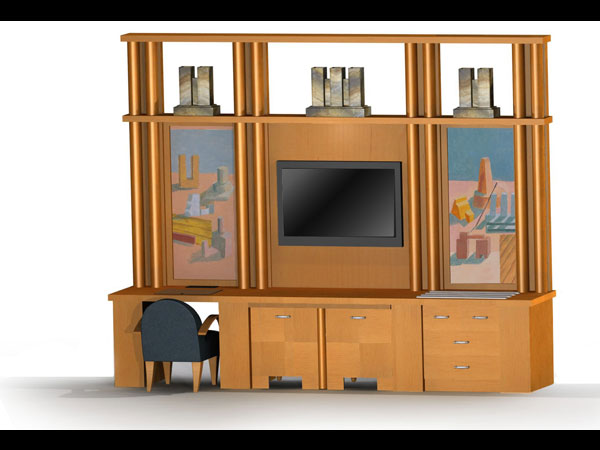 Image courtesy Resorts World Sentosa and Michael Graves & Associates.
Image courtesy Resorts World Sentosa and Michael Graves & Associates.The ingenious all-in-one guestroom console for Hotel Michael combines a built-in flat-screen TV, desk, drawers, and a luggage rack for unpacking suitcases. The desk blotter folds up to reveal a make-up mirror, and behind the center doors are a pull-out room-service table and two chairs. Paired columns support a shelf carrying faux alabaster lamps that look like little towers. Graves is a remarkably consistent designer; he used similar paired columns in 1986 for the bookshelves of his own house, and the tower forms appear in paintings of the same period. The fashion for Postmodernism may have passed, but the architect's devotion to what he calls figurative architecture persists. "All architecture before the Modern Movement sought to elaborate the themes of man and landscape," he has written. "Understanding the building involves both association with natural phenomena (for example, the floor is like the ground), and anthropomorphic allusions (for example, a column is like a man)." Or a hotel room console is like a little building.